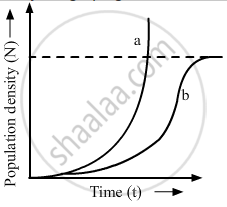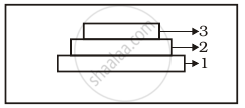Advertisements
Advertisements
Question
Study the graph given below and answer the questions that follow :

(i) Write the status of food and space in the curves (a) and (b).
(ii) In the absence of predators, which one of the two curves would appropriately depict the prey population?
(iii) Time has been shown on X-axis and there is a parallel dotted line above it. Give the significance of this dotted line
Solution
(i) There is ample food and space for the population depicted by curve (a). When the resources are unlimited, the curve is exponential. There are limiting food and space for the population depicted by curve (b). When the resources are limiting, the curve becomes sigmoid.
(ii) In the absence of predators, curve (a) would appropriately depict the prey population.
(iii) The dotted line represents the carrying capacity of the environment. The carrying capacity represents the size of population that the environment can hold by providing necessary resources. When a population reaches this line its population size is stabilised by various environmental factors.
APPEARS IN
RELATED QUESTIONS
"Analysis of age-pyramids for human population can provide important inputs for long-term planning strategies." Explain.
What is reproductive fitness? Explain it with the help of an example.
Measures of ‘Central tendency’ refer to:
Nutrient enrichment of water body result.
Population having large number of postreproductive and small number of prereproductive age group is called
The density of a population in a habitat per unit area is measured in different units. Write the unit of measurement against the following:
Banyan

Label the three tiers 1, 2, 3 given in the above age pyramid.
An individual and a population has certain characteristics. Name these attributes with definitions.
Write the best method to measure the population density of a single Banyan tree in comparison to Partlzenium weeds in a forest by an ecologist. Explain and justify your answer.
What would be the best method to measure the total population density of a dense bacterial culture in a petridish and why?
